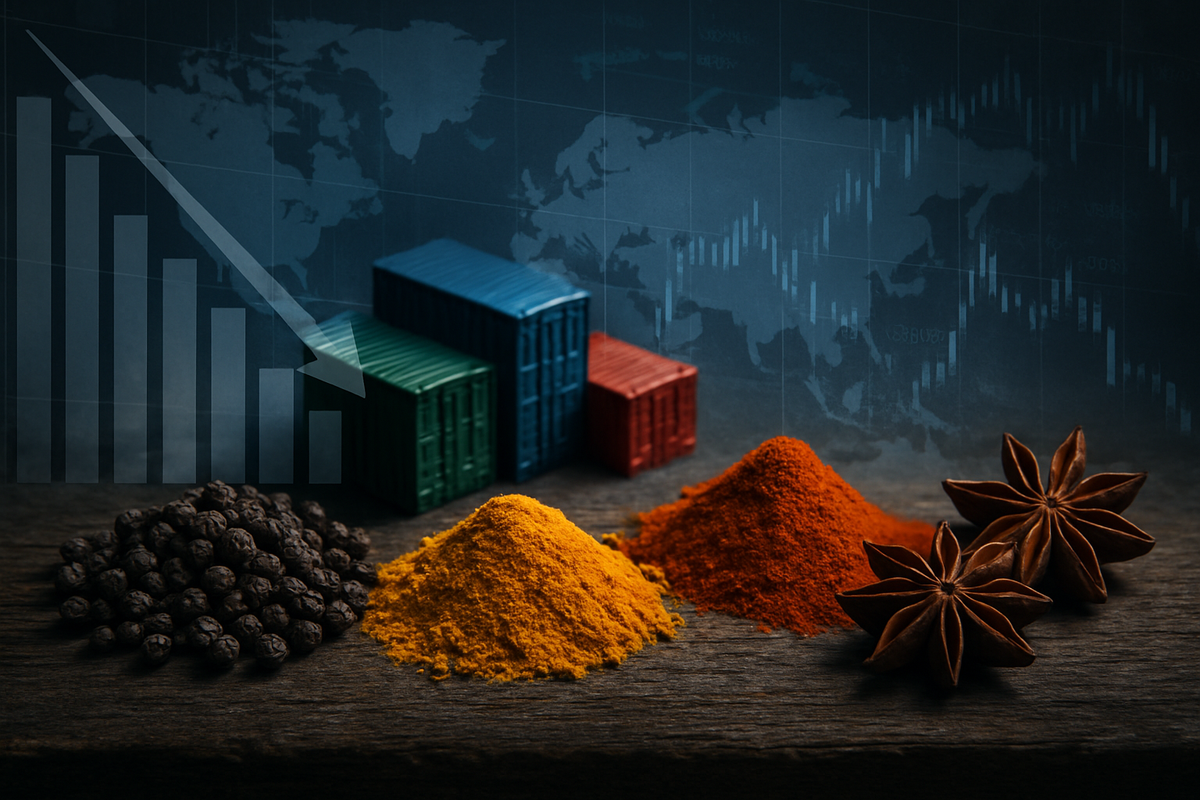Financial News
Global Trade Pressures and Tariffs Squeeze McCormick's Profit Outlook Amidst Rising Commodity Costs

Hunt Valley, MD – October 7, 2025 – McCormick & Company (NYSE: MKC), a global leader in flavor, is navigating a turbulent financial landscape as escalating global trade pressures and tariffs lead to a significant surge in commodity costs. The spice giant has explicitly stated that these headwinds are directly impacting its profit outlook for fiscal year 2025, forcing a downward revision of its earnings guidance despite a resilient performance in sales volume. This situation underscores the fragile interconnectedness of global supply chains and the immediate financial repercussions of geopolitical trade policies on multinational corporations.
The immediate implications for McCormick are clear: a trimmed profit forecast and lower guidance for earnings per share (EPS) and operating income. The company's gross annualized tariff exposure has swelled to approximately $140 million, with about $70 million directly affecting its 2025 financial results. This substantial increase from previous estimates, coupled with persistent inflation in raw material costs, is compressing McCormick's gross margins, posing a considerable challenge to its bottom line.
Detailed Coverage: Tariffs Take a Bite Out of the Spice Trade
The current trade environment, as of October 7, 2025, is characterized by a complex web of tariffs that have progressively tightened their grip on the global spice trade, directly impacting McCormick's supply chain and profitability.
Existing Section 301 tariffs on Chinese imports, which previously averaged 20-25%, saw a dramatic escalation in April 2025, with some Chinese spices facing a total tariff of 145%. Although a temporary May 2025 agreement reduced this to approximately 30% (a new 10% agreement plus prior Section 301 tariffs) for a 90-day period, the underlying trade tensions remain. Key Chinese spices affected include garlic, ginger, star anise, cassia cinnamon, and Sichuan peppercorns. Beyond China, the U.S. introduced a new 10% baseline tariff on all imported goods before July 2025, impacting spices from countries like India, Vietnam, and Mexico, which previously enjoyed duty-free access. Further, tariffs as high as 50% took effect on August 1, 2025, targeting dozens of flavoring ingredients from countries without bilateral trade agreements with Washington. This affects a wide array of spices such as vanilla (predominantly from Madagascar), cinnamon (largely from Sri Lanka), cloves, cardamom, and nutmeg. India, a major spice exporter, is significantly impacted, potentially making black pepper, turmeric, ginger, and cardamom costlier in the U.S. market.
The timeline of events leading to this moment reveals a growing storm. The spice industry has been grappling with tariff disruptions since the 2018 trade war. In March 2025, McCormick's (NYSE: MKC) CFO, Marcos Gabriel, indicated plans to offset U.S. import tariffs on China through operational cutbacks and "very targeted price adjustments." April 2025 saw a severe escalation of the U.S.-China trade dispute, leading to "heavy tariffs on almost all imported spices." A temporary "truce" in May 2025 provided some relief, but the underlying issues persisted. By June 2025, McCormick announced an estimated $90 million annual tariff burden, but robust mitigation plans allowed it to beat Q2 earnings estimates, causing its shares to surge. However, by its Q3 2025 earnings report on October 7, 2025, the company confirmed its total annualized tariff exposure had risen to $140 million, with $70 million impacting 2025 results. This led to a 120-130 basis point contraction in gross profit margin and a downward revision of its annual adjusted EPS forecast. Despite the lowered profit outlook, McCormick's stock (NYSE: MKC) showed only a marginal decline in volatile pre-market trading, and retail sentiment improved, reflecting confidence in the company's operational discipline and strategic agility.
McCormick is responding with a multi-faceted mitigation strategy, including sourcing agility through advanced analytics to optimize supplier relationships and shift procurement, internal cost controls via its Comprehensive Continuous Improvement (CCI) program, selective price adjustments, and strategic geographic diversification, such as increasing its stake in McCormick de Mexico.
Company Impact: Squeezed Margins and Strategic Shifts
The confluence of rising commodity costs and tariffs is exerting significant pressure on McCormick & Company's (NYSE: MKC) profitability and gross margins, necessitating strategic adjustments in its pricing and operational approaches.
McCormick has explicitly trimmed its profit outlook for fiscal year 2025, adjusting its adjusted operating income growth estimate downward and lowering its adjusted EPS forecast to a range of $3.00-$3.05 per share from an earlier projection of $3.03-$3.08. This revision directly reflects the increased cost burden from tariffs and commodities. The company's Q3 2025 report highlighted a 120-130 basis point contraction in its adjusted gross profit margin, primarily attributed to these external cost pressures. While McCormick's CCI program is generating substantial cost savings, these are partially offset by the incremental costs it is currently absorbing. In terms of pricing, McCormick is employing a selective and analytical approach, implementing "surgical" price adjustments, particularly in Q4 2025, to maintain profitability without significantly impacting sales volume. The company also focuses on "value innovation," introducing new products at opening price points and promoting larger pack formats to cater to cost-conscious consumers.
Within the broader spice and flavor industry, these trade pressures are creating distinct winners and losers. Large, diversified global corporations like McCormick (NYSE: MKC) are better positioned to navigate these challenges due to their extensive global supply chains, financial resources, and advanced analytics. Their ability to diversify sourcing, implement aggressive cost efficiencies, and exercise pricing power through strong brands gives them a significant advantage. Producers in countries with favorable trade agreements or tariff exemptions also stand to gain, as their products become more cost-competitive. Conversely, smaller spice companies and importers are likely to be the primary losers. They often lack the financial muscle and diversified sourcing options to absorb tariffs or quickly adapt to supply chain disruptions, leading to squeezed margins or lost market share. Exporters from tariff-targeted nations, such as India and Vietnam for black pepper or China for garlic and ginger, will find their products less competitive in affected markets, potentially leading to reduced export volumes. Companies heavily reliant on single-origin, climate-sensitive commodities also face heightened risks due to both tariffs and supply instability.
Wider Significance: A Reshaping of the Global Spice Landscape
The ongoing global trade pressures and escalating commodity costs impacting McCormick & Company (NYSE: MKC) are not isolated incidents but rather symptomatic of broader industry trends that are reshaping the entire spice and flavor landscape.
This event fits squarely into the larger narrative of supply chain disruptions, a persistent challenge for the spice industry due to factors like extreme weather, geopolitical instability, and transportation hurdles. Recent droughts affecting saffron and black pepper, coupled with historical events like Iran sanctions or the COVID-19 pandemic, underscore the vulnerability of global spice sourcing. The current tariff regime adds another layer of complexity, forcing companies to re-evaluate and diversify their raw material sourcing, investing in supply chain resilience. Simultaneously, inflation and rising commodity costs are a pervasive trend, driven by increased labor costs in producing regions, adverse weather, and geopolitical tensions. Spices like black pepper, turmeric, cumin, and coriander have all seen significant price hikes, contributing to McCormick's projected low single-digit cost inflation for 2025. This inflationary environment forces companies to balance cost absorption with strategic pricing. A concurrent trend is the growing consumer demand for natural ingredients, organic, and clean-label products, particularly functional spices like turmeric and ginger for their health benefits. This trend presents both an opportunity for companies that can sustainably source these ingredients and a challenge as tariffs make such sourcing more expensive.
The ripple effects of these pressures extend throughout the industry. Smaller competitors, lacking the scale and resources of giants like McCormick, face increased procurement costs and limited pricing power, potentially leading to market consolidation. All companies are experiencing pressure on profit margins, and many are actively seeking diversified sourcing regions to reduce reliance on tariff-affected areas, which could fundamentally shift global trade flows. Innovation in spice blends and strategic partnerships are also becoming more critical for managing costs and maintaining consumer interest.
From a regulatory and policy perspective, the global spice trade is becoming increasingly complex. Beyond the direct impact of tariffs—such as the 46% U.S. tariff on Vietnamese black pepper or the 145% on some Chinese imports—there is a growing emphasis on stricter food safety regulations, quality control, and traceability. These compliance costs add another layer of expense for producers and exporters. The imposition of tariffs also risks reciprocal tariffs from affected countries, further disrupting trade. Historically, the spice trade has always been susceptible to geopolitical events and supply disruptions. Past trade wars, economic cycles, and even ancient trade routes demonstrate that price volatility and supply chain challenges are not new phenomena, but the current confluence of factors presents a unique and intense challenge.
What Comes Next: Navigating Uncertainty with Strategic Agility
As McCormick & Company (NYSE: MKC) moves forward, the short-term and long-term possibilities are shaped by its ability to adapt to persistent global trade pressures and rising commodity costs, requiring strategic pivots and an eye on emerging market dynamics.
In the short term, McCormick is focused on immediate mitigation. This includes continued reliance on revenue growth management and selective pricing actions to offset cost increases, though Q3 growth was predominantly volume-led. The company's Comprehensive Continuous Improvement (CCI) program remains vital for driving operational efficiencies and generating cost savings, helping to absorb the estimated $70 million in tariff impacts for 2025. Furthermore, supply chain optimization and strategic sourcing using advanced analytics are crucial for navigating the complex trade environment and minimizing tariff exposure.
For the long term, McCormick is positioning itself through several strategic pivots. It is committed to continued investment in brands and innovation, focusing on flavor enhancement, high-growth categories like plant-based and global spice blends, and expanded distribution to drive sustained volume-led growth. Geographic diversification and market expansion are also key, evidenced by the planned acquisition of an additional 25% ownership in McCormick de Mexico. This move aims to significantly boost emerging market sales and shift the company's portfolio, with emerging markets projected to contribute 25% of total sales. This aligns with the broader industry trend of tapping into the global spice market, expected to exceed $41 billion by 2033. Digital transformation and e-commerce are also expected to play a crucial role in reaching wider markets and opening new sales channels.
Emerging markets present a mixed bag of opportunities and challenges. While regions like EMEA (Europe, Middle East, and Africa) have shown strong organic growth for McCormick's Consumer segment, the APAC region, particularly China's foodservice business, has experienced softness due to slowing demand and increased competition, compounded by U.S.-China tariff tensions. Geopolitical tensions in other regions have also impacted the Flavor Solutions segment. The ongoing uncertainty around new or retaliatory tariffs, especially from major trading partners, remains a significant risk.
Potential scenarios range from resilient adaptation—where McCormick successfully navigates pressures through current strategies, maintaining modest growth—to an optimistic case where trade tensions ease, commodity costs stabilize, and strong consumer demand drives accelerated growth. However, a pessimistic scenario could see intensified trade wars, stubbornly high commodity costs, and weakening global consumer spending, leading to further margin contraction and downward revisions of profit outlooks. McCormick's strategic agility and commitment to cost savings and diversification will be paramount in determining its trajectory.
Wrap-up: A Test of Resilience in a Flavorful Market
McCormick & Company (NYSE: MKC) is currently undergoing a significant test of its resilience, demonstrating a strategic and proactive approach to navigating the profound challenges posed by global trade pressures and escalating commodity costs. The company's Q3 2025 results underscore a period of volume-led growth tempered by notable margin compression, highlighting the immediate and far-reaching impact of external economic forces on even the most established players in the food industry.
Key Takeaways from this dynamic period include McCormick's sustained volume growth despite headwinds, a significant contraction in gross profit margins driven by tariffs and commodity inflation, and the company's substantial annualized tariff exposure of $140 million, with $70 million directly affecting 2025 results. Crucially, McCormick's proactive mitigation strategies, including its robust CCI program, strategic sourcing, and targeted pricing, are proving essential in buffering these impacts, even as the company has trimmed its profit outlook for the year.
Moving forward, the broader spice industry is projected for substantial growth, fueled by evolving consumer tastes, a surge in demand for ethnic cuisines, and a growing preference for natural and functional ingredients. However, this growth narrative is shadowed by persistent challenges: vulnerable supply chains susceptible to climate change and geopolitical events, continuously rising commodity prices (especially for key spices like black pepper), and the complex web of regulatory barriers and tariffs. For McCormick, the market outlook remains cautiously optimistic. Its focus on volume-led growth, particularly in the Consumer segment, combined with strategic investments in innovation and brand marketing, positions it to capitalize on underlying industry trends. Yet, the sensitivity of its Flavor Solutions segment to macroeconomic pressures remains a point of vulnerability.
The significance and lasting impact of these events will likely be a more diversified, resilient, and technologically advanced global supply chain for McCormick. The necessity to adapt quickly will foster enhanced operational efficiencies and a reinforced commitment to innovation in flavor solutions that cater to evolving consumer preferences and value-seeking behaviors. The emphasis on sustainable sourcing and transparent practices, driven by both cost pressures and consumer demand, will continue to reshape the industry's ethical and operational frameworks. This period serves as a powerful reminder of the interconnectedness of global markets and the critical importance of agile decision-making in an unpredictable world.
Investors should watch for several key indicators in the coming months. The continued effectiveness of McCormick's mitigation strategies, particularly the CCI program and alternative sourcing, will be paramount in determining its gross margin trajectory. Sustained volume growth, especially in the Consumer segment, and any signs of recovery in the Flavor Solutions segment will be crucial. Investors should also closely monitor global trade policy developments, future tariff announcements, and trends in key spice commodity prices. The success of new product launches, McCormick's ability to maintain market share, and any further adjustments to its fiscal 2025 or initial 2026 guidance will provide critical insights into the company's performance and the evolving market conditions. Finally, the company's cash flow from operations and capital allocation strategies will be important for long-term value creation.
This content is intended for informational purposes only and is not financial advice
More News
View More




Recent Quotes
View MoreQuotes delayed at least 20 minutes.
By accessing this page, you agree to the Privacy Policy and Terms Of Service.



